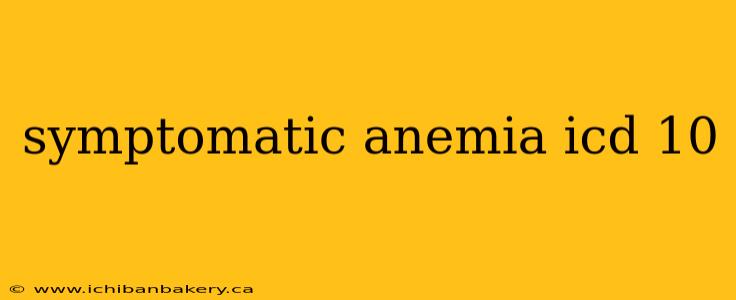Meta Description: Dive deep into symptomatic anemia! This comprehensive guide explains ICD-10 codes for various anemias, their symptoms, causes, diagnosis, and treatment. Learn how to identify and manage this prevalent condition effectively. Understand the nuances of different anemia types and their associated ICD-10 classifications for accurate medical record-keeping and improved patient care.
Understanding Anemia and its Symptoms
Anemia, broadly defined, is a condition characterized by a deficiency of red blood cells or hemoglobin in the blood, resulting in reduced oxygen-carrying capacity. This deficiency can manifest in a wide array of symptoms, making accurate diagnosis crucial. Symptomatic anemia, as the name suggests, is anemia that presents with noticeable clinical signs and symptoms. The severity of symptoms varies widely depending on the underlying cause, the rate of onset, and the individual's overall health.
Common Symptoms of Symptomatic Anemia
Several symptoms can indicate symptomatic anemia. These include:
- Fatigue and Weakness: This is often the most common and early symptom. The lack of oxygen reaching tissues leads to widespread tiredness.
- Shortness of Breath (Dyspnea): Reduced oxygen levels in the blood strain the respiratory system, causing shortness of breath, even during minimal exertion.
- Palpitations: The heart compensates for low oxygen levels by beating faster, leading to a noticeable racing heartbeat.
- Pale Skin (Pallor): A reduction in red blood cells reduces the skin's rosy hue, resulting in a pale appearance, especially noticeable in the gums and nail beds.
- Headaches: Oxygen deprivation can cause headaches and dizziness.
- Dizziness and Lightheadedness: A lack of oxygen to the brain can cause these symptoms.
- Cold Hands and Feet: Poor circulation due to anemia can lead to cold extremities.
Less Common, but Important Symptoms
While less frequent, other symptoms to watch for include:
- Chest Pain: In severe cases, the heart's increased workload can cause chest pain.
- Leg Cramps: Muscle fatigue and reduced oxygen delivery can lead to cramps.
- Brittle Nails: Anemia can affect nail health, resulting in fragility and breakage.
Causes of Anemia: A Diverse Spectrum
The causes of anemia are diverse and complex, ranging from nutritional deficiencies to chronic diseases. Several categories contribute to anemia development:
- Nutritional Deficiencies: Iron deficiency anemia, the most common type, results from insufficient iron intake or impaired iron absorption. Vitamin B12 and folate deficiencies also lead to anemia.
- Blood Loss: Chronic blood loss, often due to heavy menstrual bleeding, gastrointestinal bleeding (e.g., ulcers), or internal injuries, can deplete red blood cells.
- Bone Marrow Disorders: Conditions affecting the bone marrow's ability to produce red blood cells, such as aplastic anemia or leukemia, can cause anemia.
- Hemolytic Anemias: These anemias result from the premature destruction of red blood cells, potentially due to genetic disorders (e.g., sickle cell anemia) or autoimmune diseases.
- Chronic Diseases: Chronic illnesses like kidney disease, rheumatoid arthritis, and cancer can suppress red blood cell production.
Diagnosis of Symptomatic Anemia
Diagnosing symptomatic anemia involves a combination of physical examination, medical history review, and laboratory tests.
1. Physical Examination: A doctor assesses symptoms and physical findings like pallor and heart rate.
2. Complete Blood Count (CBC): This is the primary test, measuring hemoglobin levels, red blood cell count, hematocrit, and other blood components.
3. Peripheral Blood Smear: This microscopic examination assesses the shape and size of red blood cells, providing clues about the type of anemia.
4. Further Investigations: Depending on the CBC and smear results, additional tests such as iron studies, vitamin B12 and folate levels, and bone marrow biopsy may be necessary to identify the underlying cause.
ICD-10 Codes for Anemia
The International Classification of Diseases, Tenth Revision (ICD-10) uses specific codes to classify anemias. These codes are crucial for medical record-keeping, billing, and epidemiological studies. It's important to note that ICD-10 codes should be assigned by a qualified healthcare professional based on a proper diagnosis. The following are examples, and the specific code will depend on the type and cause of the anemia:
- D50-D64: This broad range covers various types of anemias, including iron deficiency anemia (D50), megaloblastic anemia (D51), and other specified anemias (D64).
- Specific Codes: More detailed codes exist to specify the underlying cause and type of anemia. For example, a specific code may exist for anemia due to chronic kidney disease.
Always consult the official ICD-10 manual for the most up-to-date and accurate coding information.
Treatment of Symptomatic Anemia
Treatment strategies for symptomatic anemia are tailored to the underlying cause. They may include:
- Iron Supplements: For iron deficiency anemia.
- Vitamin B12 or Folate Supplements: For deficiencies of these vitamins.
- Medication: For underlying conditions causing anemia.
- Blood Transfusions: In severe cases or during acute blood loss.
- Surgery: For conditions causing blood loss (e.g., removal of a bleeding ulcer).
- Bone Marrow Transplant: In certain cases of severe bone marrow disorders.
Conclusion
Symptomatic anemia is a complex condition with diverse causes and presentations. Accurate diagnosis through thorough clinical evaluation and laboratory testing is vital for effective treatment. Understanding the associated ICD-10 codes ensures proper medical record-keeping and facilitates better communication among healthcare providers. Remember to consult your physician for diagnosis and management of anemia. Early diagnosis and appropriate treatment can significantly improve symptoms and overall health outcomes.
